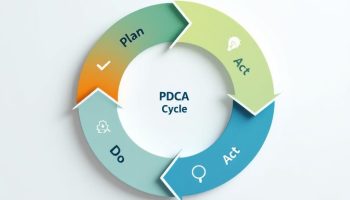
Understanding Lean Thinking Principles
Lean thinking principles create the foundation for operational excellence in modern business. The five core principles—defining value from the customer’s perspective, mapping value streams, establishing continuous flow, implementing pull systems, and pursuing perfection through Kaizen—work together as an integrated system. This approach eliminates waste while maximizing customer value, streamlines processes, and optimizes resource usage.
Business Impact and Necessity
Lean thinking principles give organizations a competitive advantage in today’s fast-paced market by cutting costs while enhancing quality and delivery times. Companies that adopt these principles typically see 25-30% productivity gains, 50-90% shorter lead times, and notable reductions in inventory expenses.
Beyond the numbers, lean thinking develops an organizational culture focused on continuous improvement. This culture empowers staff at every level to spot inefficiencies and offer valuable solutions. As competition intensifies and customer demands grow, these principles have transformed from optional strategies into essential business practices for long-term growth.
Lean principles help you address complex business challenges with straightforward, practical solutions. Your organization can respond more quickly to market changes while maintaining high-quality standards and customer satisfaction.
Unlocking Success: 5 Lean Thinking Principles You Can Implement Today
In an ever-evolving business landscape, harnessing lean thinking principles can be a game-changer for efficiency and customer satisfaction. These principles focus on eliminating waste and optimizing processes to create value from the customer’s perspective. In this section, we’ll explore five essential lean thinking principles that can help you streamline operations, enhance product quality, and cultivate a culture of continuous improvement. Whether you’re new to lean methodology or looking to deepen your understanding, these actionable strategies will guide you toward achieving operational excellence. Dive into each principle to discover how you can take immediate steps to revolutionize your organization’s approach and drive sustainable growth.
1. Define Value Through Customer Perspective
Implementing lean thinking principles starts with understanding what your customers truly value. This customer-centric approach forms the foundation of lean methodology by helping you distinguish between activities that add value and those that don’t. To effectively define value, you need to establish direct communication channels with your customers through surveys, interviews, and focus groups.
Value stream analysis tools help you visualize how value flows through your organization. Consider using these methods to gather insights:
- Customer journey mapping to track experience touchpoints
- Voice of customer (VOC) data collection
- Net Promoter Score (NPS) surveys
- Value analysis workshops with cross-functional teams
Avoid common mistakes when defining value, such as making assumptions about customer needs without validation or failing to practice active listening during feedback sessions. Remember that value definition isn’t a one-time exercise but requires ongoing reassessment as customer preferences evolve and market conditions change.
2. Map and Optimize Your Value Stream
Applying lean thinking principles effectively requires a comprehensive understanding of your value stream. By mapping the flow of materials and information, you can identify areas where value is created or diminished. Value stream mapping provides a visual representation that helps spotlight bottlenecks and wasteful activities.
When implementing lean thinking principles, focus on creating detailed process maps that capture both the current and future state of your operations. These maps should document:
- Every step in your production or service delivery process
- Wait times between activities
- Information flows across departments
- Decision points and approval processes
- Quality check locations
Cross-functional collaboration is essential when optimizing your value stream with lean principles. Involve team members from different departments to gain diverse perspectives on process inefficiencies. This collaborative approach helps break down silos that often hide waste.
Data validation plays a crucial role in confirming that your improvements align with lean thinking principles. Track key metrics before and after changes to quantify gains and identify areas needing further optimization. This evidence-based approach ensures your process improvements deliver meaningful results.
Expert Insight: To optimize your value stream, create detailed process maps capturing current and future states, including all steps, wait times, and information flows. Engage cross-functional teams to gain diverse insights and validate data through key metrics to ensure your improvements align with lean principles for impactful results.
3. Establish Continuous Flow
Implementing lean thinking principles in your process flow is crucial for operational excellence. Continuous flow eliminates wasteful interruptions that hamper productivity and quality. When you establish smooth workflows, you reduce waiting time between process steps and minimize batch processing.
Standardized work forms the foundation of continuous flow, ensuring consistency across operations. By documenting best practices and creating clear work instructions, you enable teams to perform tasks efficiently while maintaining quality standards. This standardization serves as a baseline for continuous improvement efforts.
The 5S system (Sort, Set in order, Shine, Standardize, Sustain) creates an organized workplace that supports flow. Consider implementing these practical techniques:
- Visual management boards to track progress and highlight problems
- Cellular layouts that minimize movement between workstations
- Cross-training team members to support balanced workloads
- Quick changeover techniques to reduce downtime
Balance work carefully across your team to prevent overburden. When implementing project implementation phases, ensure each step proceeds at a consistent pace to avoid bottlenecks or idle time.
Expert Insight: To establish continuous flow, implement lean principles by standardizing work processes and utilizing the 5S system for organization. Balance workloads and minimize movement with cellular layouts and cross-training. Regularly track progress with visual management tools to identify and address issues promptly, enhancing overall productivity and efficiency.
4. Implement Pull Systems
Incorporating lean thinking principles into your production flow requires a shift from traditional push systems to more efficient pull systems. Pull systems reduce waste by producing only what customers need when they need it. This core lean thinking principle drives organizations to optimize their operations around actual demand.
Just-in-time production represents the heart of pull systems, allowing you to minimize inventory while maintaining service levels. By implementing a Kanban system for project management, you create visual signals that trigger production based on actual consumption. This visual approach makes workflow bottlenecks immediately visible.
Effective inventory management strategies further support lean thinking by:
- Reducing carrying costs
- Minimizing storage space requirements
- Decreasing obsolescence risk
- Improving cash flow
Demand-based scheduling aligns your production capacity directly with customer requirements. This approach requires close collaboration with suppliers through supply chain optimization techniques that extend lean principles beyond your organization’s boundaries.
Expert Insight: To enhance efficiency, transition from push to pull systems by implementing just-in-time production and a Kanban system. This reduces waste, minimizes inventory, and aligns production with actual customer demand. Foster collaboration with suppliers to optimize your supply chain further, ensuring streamlined operations and improved cash flow.
5. Pursue Perfection Through Kaizen
The journey of lean thinking principles culminates in the relentless pursuit of perfection through Kaizen—the Japanese concept of continuous improvement. Implementing daily improvement routines helps teams identify small opportunities that yield significant results over time.
You can establish effective problem-solving methodologies like the PDCA (Plan-Do-Check-Act) cycle to systematically address issues in your processes. Kaizen in practice requires thoughtful employee engagement techniques, as frontline workers often have the most valuable insights into operational inefficiencies.
To drive meaningful change, implement these key elements:
- Morning huddles to identify daily improvement opportunities
- Suggestion systems that recognize and reward improvement ideas
- Cross-functional improvement teams that tackle complex challenges
- Root cause analysis techniques like the 5 Whys and fishbone diagrams
Performance measurement systems are essential for tracking your continuous improvement efforts. Establish meaningful KPIs that align with your strategic goals and continuous improvement initiatives. Creating a sustainable improvement culture requires leadership commitment, regular training, and celebrating small wins that reinforce the importance of perfection-seeking behaviors.
Expert Insight: Embrace Kaizen for continuous improvement by fostering a culture of daily progress through morning huddles and suggestion systems. Utilize problem-solving methodologies like the PDCA cycle and engage frontline employees for insights. Regularly track performance with aligned KPIs to solidify your commitment to perfection and sustainable growth.
The Five Lean Thinking Principles
The five lean thinking principles—defining customer value, mapping value streams, establishing continuous flow, implementing pull systems, and pursuing perfection through Kaizen—form a comprehensive framework for operational excellence. These principles work together to eliminate waste, optimize processes, and create a culture of continuous improvement that transforms how organizations deliver value to customers.
Importance of Lean Thinking Principles
Lean thinking principles provide enterprise organizations with the methodical approach needed to survive in today’s competitive landscape by systematically eliminating inefficiencies that drain resources and hamper growth. By implementing these five essential strategies:
- Customer value definition
- Value stream mapping
- Continuous flow establishment
- Pull system implementation
- Pursuit of perfection through Kaizen
Businesses can reduce operational costs, improve quality, accelerate delivery times, and enhance customer satisfaction while building organizational resilience against market disruptions.






